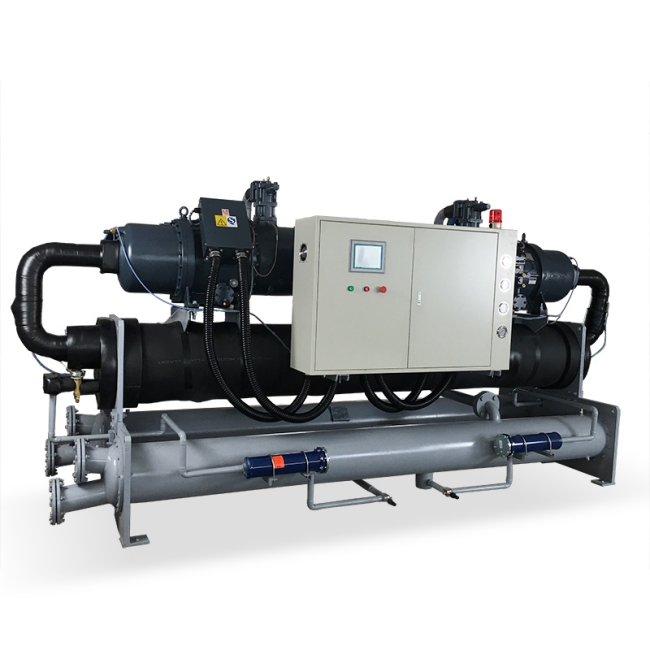Water Usage and Disposal Concerns:
A major drawback of water-cooled chillers is the amount of water they use. A large quantity of water is consumed by these systems while they are operating since they depend on a constant water flow to remove heat from the refrigerant. This can be problematic in areas where water is limited or where there are stringent restrictions on water use.
Additionally, there may be problems with disposing of the water used for cooling. As the water absorbs the heat from the refrigerant, it becomes hotter; releasing this hot water back into the environment, particularly without adequate treatment, can harm local ecosystems. The operational costs of the chiller system may also increase if the discharge is required to fulfill specific environmental criteria.
The Danger of Water Leakage and Contamination:
The potential for water leakage and contamination in water-cooled chillers is a major concern, since it could lead to harmful effects on both people and the environment. The release of chemicals, refrigerants, or contaminants into the land, water sources, or air can occur if the piping system or cooling towers develop leaks.
In addition, microorganisms like algae and bacteria can grow in the cooling system of water-cooled chillers. These organisms pose a threat to human health and operational difficulties if they are not controlled and kept in good condition. Additionally, the internal components of the chiller system might corrode from contaminated water, which can cause system failures or higher maintenance needs. Ensuring that water-cooled chiller systems are properly monitored and maintained is crucial for reducing the danger of water leakage and contamination.
Vulnerability to Water Supply Interruptions:
In the event of a water shortage, building breakdown, or other disruption in the delivery of water, water-cooled chillers could be severely damaged or even destroyed. Downtime and loss of cooling capacity can occur from any interruption to the water flow to the chiller system, which in turn impacts the operations of the facility or process being cooled.
Because water-cooled chiller systems aren’t always reliable in areas with water shortages or droughts, businesses in those areas may look into other cooling options or put money into storage tanks or water recycling systems as a backup. It is crucial to have a strategy in place for resilience and risk management for water-cooled chillers since severe weather events like storms and floods can harm water infrastructure and interrupt their operation.
Initial Capital Investment:
Compared to air-cooled alternatives, water-cooled chillers usually need a greater initial capital investment. A water-cooled chiller system’s initial investment could be higher than expected due to the need to establish cooling towers, pipe systems, and related infrastructure. In addition, the upfront cost can go up since water-cooled chiller systems are complex and may necessitate specialist knowledge during the design, installation, and operating processes.
To find out if water-cooled chillers are worth it, businesses should consider the initial investment in addition to the energy savings and operational advantages they will get in the long run. As businesses look to maximize their investments and strike a balance between cost, performance, and sustainability, financing choices and incentives for energy-efficient cooling technology may also have an impact on the decision-making process.
Installation Flexibility:
When compared to air-cooled systems, water-cooled chillers offer less installation flexibility. There are few places that can accommodate water-cooled chillers due to the necessity of cooling towers and an ongoing water supply. In congested cities or on small plots of land, it could be difficult to locate water treatment plants and cooling towers, which is a major inconvenience.
In addition, existing buildings or infrastructure may need to be modified to accommodate the increased space and support structures needed for cooling towers and water circulation systems when water-cooled chillers are installed. These adjustments can make water-cooled chiller systems more complicated and expensive to install, which can make them impractical in some cases.
Legionella Growth Potential:
The cooling towers and pipe systems of water-cooled chillers can be a breeding ground for the bacteria Legionella. Legionnaires’ disease, a severe type of pneumonia, and other respiratory disorders can be caused by the pathogenic bacterium Legionella.
Regular maintenance and cleaning of water-cooled chiller systems is necessary to minimize the accumulation of biofilms and bacterial growth, thus reducing the risk of Legionella contamination. To do this, water treatment techniques like chlorination or biocide treatments must be put into place, and regular inspections and testing must be carried out to guarantee the water is safe to drink.
Legionella contamination is a major public health concern, and building owners and facility managers run the danger of legal trouble and damage to their reputations if they don’t take proper precautions to prevent it. To reduce the likelihood of Legionella growth in chiller systems that use water for cooling, it is crucial to perform regular maintenance and use mitigation strategies.
Complexity of Water Treatment:
In order to keep the water quality high and avoid problems like corrosion, bacterial development, and scale accumulation in the cooling system, specialist water treatment is necessary for water-cooled chillers. To accomplish this, procedures for water treatment such as chemical treatment, filtration, and pH adjustment are put into place to maintain an ideal water chemistry balance and safeguard chiller components from harm.
It can be difficult for facility managers and operators to handle the water treatment for water-cooled chillers due to its complexity. This is especially true when it comes to choosing the right treatment methods and efficiently monitoring the water quality. Problems with operation, decreased efficiency, and increased maintenance needs for chiller systems can result from improper water treatment.
In addition, the operational expenses of water-cooled chillers might be increased by the cost of chemicals and equipment used for water treatment and by the necessity for specific knowledge in this area. If businesses want their chiller systems to last and work reliably, they need to put money into water treatment programs and maintenance procedures.


